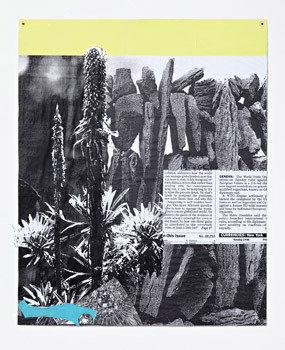Kirstine Roepstorff
dal 21/10/2011 al 18/2/2012
Segnalato da
21/10/2011
Kirstine Roepstorff
National Museum of Contemporary Art, Oslo
Wunderkammer of Formlessness. The aesthetic expression of her work ranges from the whispering and the discreet to the provocative and multi-faceted. The exhibition, based on the Wunderkammer theme, is like a special treasure chest in which Roepstorff exhibits her own work together with objects she has hand-picked from museum collections or jumble sales: newspaper and magazine cuttings, as well as fabrics and yarn that have been glued and woven together in intriguing compositions. Her wunderkammer assembles high fir trees, crystals, sculptures and display cabinets with various objects such as geological findsstones and golden keys.

curated by Andrea Kroksnes
– I am attracted to shapes, but most of all to the space that exists between the shapes, says Kirstine Roepstorff. The inspiration behind her pictures mainly comes from reading a wide range of international publications on a regular basis.
Kirstine Roepstorff is interested in most world affairs, whether it is about what is going on in East Timor, Darfur or Greenland. She keeps herself constantly updated with what is happening in different parts of the world although she does not own a TV. However, she regularly reads Der Spiegel, TIME, National Geographic, various newspapers, or uses the Internet. It is through such media that she draws inspiration for her works.
The aesthetic expression of her work ranges from the whispering and the discreet to the provocative and multi-faceted. This exhibition is based on the Wunderkammer theme. It is like a special treasure chest in which Kirstine Roepstorff exhibits her own work together with objects she has hand-picked from museum collections or jumble sales. The walls are covered in curtains and provide a concentrated, almost solemn, atmosphere. Magnificent collages display newspaper and magazine cuttings, as well as fabrics and yarn that have been glued and woven together in intriguing compositions. Roepstorff’s wunderkammer assembles high fir trees, crystals, sculptures and display cabinets with various objects such as geological findsstones and golden keys. The central piece is the work Stille Teater (Silent Theatre). The ‘actors’ in this kinetic theatre play are magical glass sculptures that move to light and sound.
The themes in Kirstine Roepstorff’s oeuvre range from the figurative to contemporary politics to mystical fantasies and the grotesque. She is constantly discovering new ways in which to use materials. Often she works with time-honoured feminine artisan materials such as yarn, embroidery, paper cuttings and fabrics, which she fuses into a powerful political statement. This collision between content and materials has parallels with feminist art from the 1970s. However, contrary to the feminists of the 1970s whose focus were gender issues, Kirstine Roepstorff does not offer any quick-fix solutions to society’s problems. She simply acknowledges them and confronts us with them in poetic and often humorous ways.
Kirstine Roepstorff was born in 1972 in Denmark and lives and works in Berlin and Copenhagen. Roepstorff attended the Royal Danish Academy of Art in Copenhagen from 1994–2001 and Rutgers University, Mason School of Fine Art, from 1999–2000. She has had a number of solo exhibitions in Museums and art institutions internationally such as Galerie im Taxispalais, Innsbruck, Austria; Museum für Gegenwartskunst/Kunstmuseum Basel, Switzerland; Kunsthallen Brandts, Odense, Denmark; Musac, Leon, Spain and Bonnierskonsthall, Stockholm, Sweden. She is represented by Peres Projects in Berlin and Galleri Christina Wilson in Copenhagen.
The accompanying exhibition catalogue «Dried Dew Drops. Wunderkammer of Formlesness» is a co-production between the National Museum in Oslo and the Museum für Gegenwartskunst Basel. It is published by Hatje Cantz. Rare ethnografic artifacts and precious stones are borrowed from the Museum of Cultural History and the Natural History Museum in Oslo respectively. The trees are from Ragnhild and Olav Prestvik’s woods in Nittedal outside Oslo.
The exhibition's curator is senior curator Andrea Kroksnes. The project supervisor is Anita Rebolledo.
Image: Kirstine Roepstorff, "The King is Dead #11," 2008. Courtesy Peres Projects
Press contact
Elise Lund
Press Manager
Tel.: +47 21 98 22 12, mobile +47 993 21 942
E-mail: elise.lund@nasjonalmuseet.no
Jean-Yves Gallardo
Director of Communications
Tel.: +47 21 98 22 42, mobile +47 992 89 629
E-mail: jean-yves.gallardo@nasjonalmuseet.no
Opening: 22 October at 2 p.m.
The Nation Museum of Contemporary Art
Bankplassen 4 - Oslo
Opening hours:
Tue- Fri 11.00–17.00
Thursday 11.00–19.00
Sat-Sun 12.00–17.00
Monday closed



